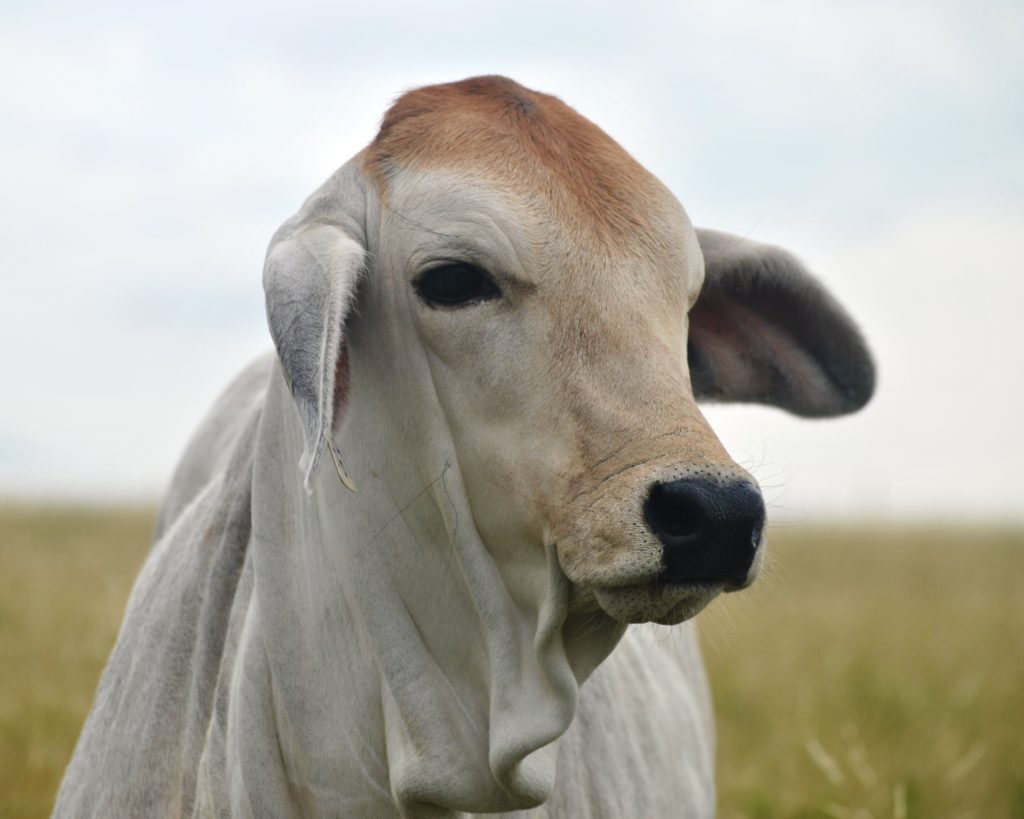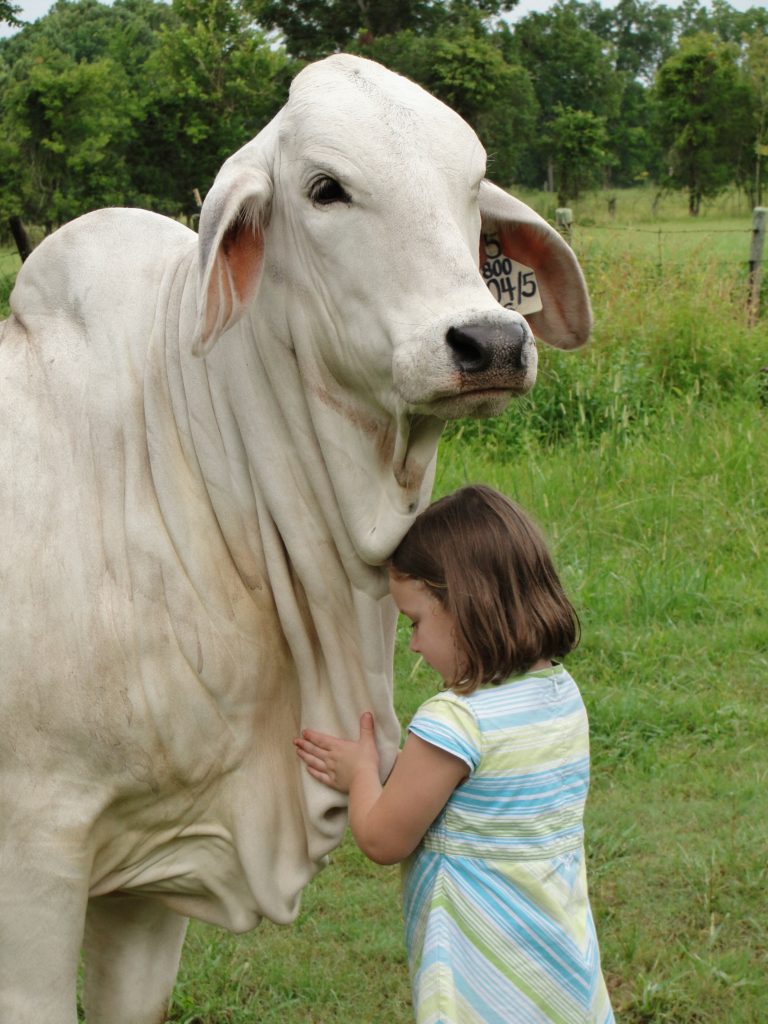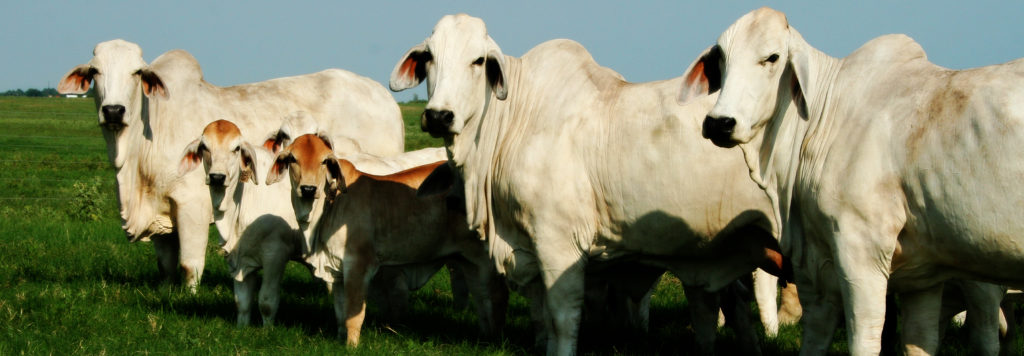
Brahman Cow Photo By: ABBA
Why Texas Loves Brahman Cattle
Article Provided By: American Brahman Breeders Association
In the Southern United States, the cattle are still king, but so is the heat. Though it varies from coast to coast, the majority of the region spends almost a third of the year facing temperatures over 90 degrees and almost half the year with temperatures over 85 degrees—a climate uncomfortable to humans, but potentially deadly to livestock.
Originating from several Indian breeds of cattle that thrived in regions where insects, disease, dry harsh terrain and the extreme temperatures were the norm, the Brahman is a true masterpiece of genetic design—a breed as easy to raise as they are to recognize.
A product of the Guzerat, the Gir, the Nellore and the Krishna Valley breeds, the American Brahman was born of necessity for hearty beef- and milk-producing cattle that would not struggle amid the often un-cattle-friendly Gulf Coast climate. Similar in appearance to the Zebu (or Bos indicus) native to India, Brahmans feature a variety of colors (light gray, red and black), but a well-defined hump between the shoulder blades and heavy dewlap under the neck are the truly distinctive traits.

Photo Provided by: ABBA
For Brahman, every aspect of their physique contributes to their productivity and resilience. To protect themselves from the sun’s rays and excessive heat, Brahmans have dark pigmentation encircling the eyes that helps prevent cancer eye, loose skin with thick, glossy hair (with reduced sulphur demand for growth) that provides a thermal barrier and an increased size, number and productivity of sweat glands that allow them to sweat freely.
Normally, where heat reigns, forage suffers. In addition, Brahmans better utilize low-quality browse and require less water intake (resulting in reduced urination and nitrogen loss). Their digestive efficiency allows for superior muscle and tissue development even on low feed intake, as well as the ability to recycle nutrients through the blood stream and saliva. Their cattle tick resistance stems from a sleek coat unfavorable for tick attachment, an immune response that prevents tick development and chemicals in the sweat that act as a repellant. Brahmans can also travel extensively and produce the maximum quality of beef and milk from minimal resources.
“What’s exceptional about Brahman’s is their low maintenance and adaptability,” said Chris Shivers, executive vice president and a 14-year member of the American Brahman Breeders Association (ABBA) Staff. “These animals will survive in places where raising cattle was thought impossible, and the rate of their influence has expanded faster than any other breed in the world. At ABBA, our priority is to educate cattle producers about these wonderfully diverse animals and the numerous benefits they bring to the ranching lifestyle.”

Alone, Brahman cattle offer a wealth of positive aspects, but when crossbred with European Bos taurus, the result is exceptional hybrid vigor (heterosis). This term refers to crossbred offspring who possess superior traits to their parents—a result most effective when breeds with differing traits are introduced.
For example, Bos taurus are known for their excellent muscle patterning and beef production, but are highly susceptible to heat and disease. Bos indicus function well in rough climates and are known for their adaptability, hardiness and efficient beef production. American Brahmans marry the best of both parents, and when partnered with varying breeds, naturally produce high-quality first-cross (F1) offspring. Second to none in attaining this level of heterosis, this innovative crossbreeding results in offspring with superior weight, carcass efficiency and reproductive performance.

Photo Provided By: ABBA
F1 females possess an unprecedented maternal instinct. Born to nurture, the females have a lifespan that surpasses that of any European breed, an extended breeding window, often 50% longer than many other breeds, a fierce protective nature toward calves from predators and the ability to produce high-quality milk in vast quantities.
“In essence, an F1 female is unmatched. She has a higher bred-in environmental adaptivity, increased milk production, higher fertility and heat and the disease resistance of her Brahman parent,” Shivers said. “These aren’t your regular cattle. They’re strong, resilient and are highly regarded by commercial cattlemen as a maternal machine with few peers. And their offspring are a direct reflection of that quality.” Due to these profitable traits, cattlemen demand the F-1 female and are willing to pay more due to these cattle doing more for longer. A recent analysis was done of the major stock show sales in the State of Texas and it was found that the ABBA Golden Certified and Certified (verified genetics) cattle brought a premium of over $200/head compared to the other breeds and breed crosses. This is significant where it counts the most, the trips to the bank.
In addition, F1 steers have their own distinct set of attributes, including rapid growth, efficient gaining and excellent beef quality. They produce high-cutability carcasses with less excessive fat, but still retain the exceptional standard of quality, flavor and tenderness in demand worldwide.

Today, American Brahmans have found homes around the world, with local ranchers and breeders importing the cattle in order to improve the quality of native livestock. From Mexico to South America and Asia to Australia, American Brahmans have made their mark where cattlemen desire the best performance from their herd. When considering a breed known for exceptional production, maximum efficiency and unparalleled versatility, Brahman is the choice for all the right reasons.
Not only is the American Brahman a great breed of cattle, but is backed by a great organization. Founded in 1924, the American Brahman Breeders Association is headquartered in Houston, Texas and is the Official Breed Registry for the American Brahman Breed. In addition to maintaining the parentage and ownership records of the American Brahman cattle, they also offer a number of membership, breed improvement, promotion, marketing and educational programs.
For more information on the American Brahman and the American Brahman Breeders Association, please contact Executive Vice President Chris Shivers at 713 349-0854 or cshivers@brahman.org. Visit www.brahman.org for more details.
